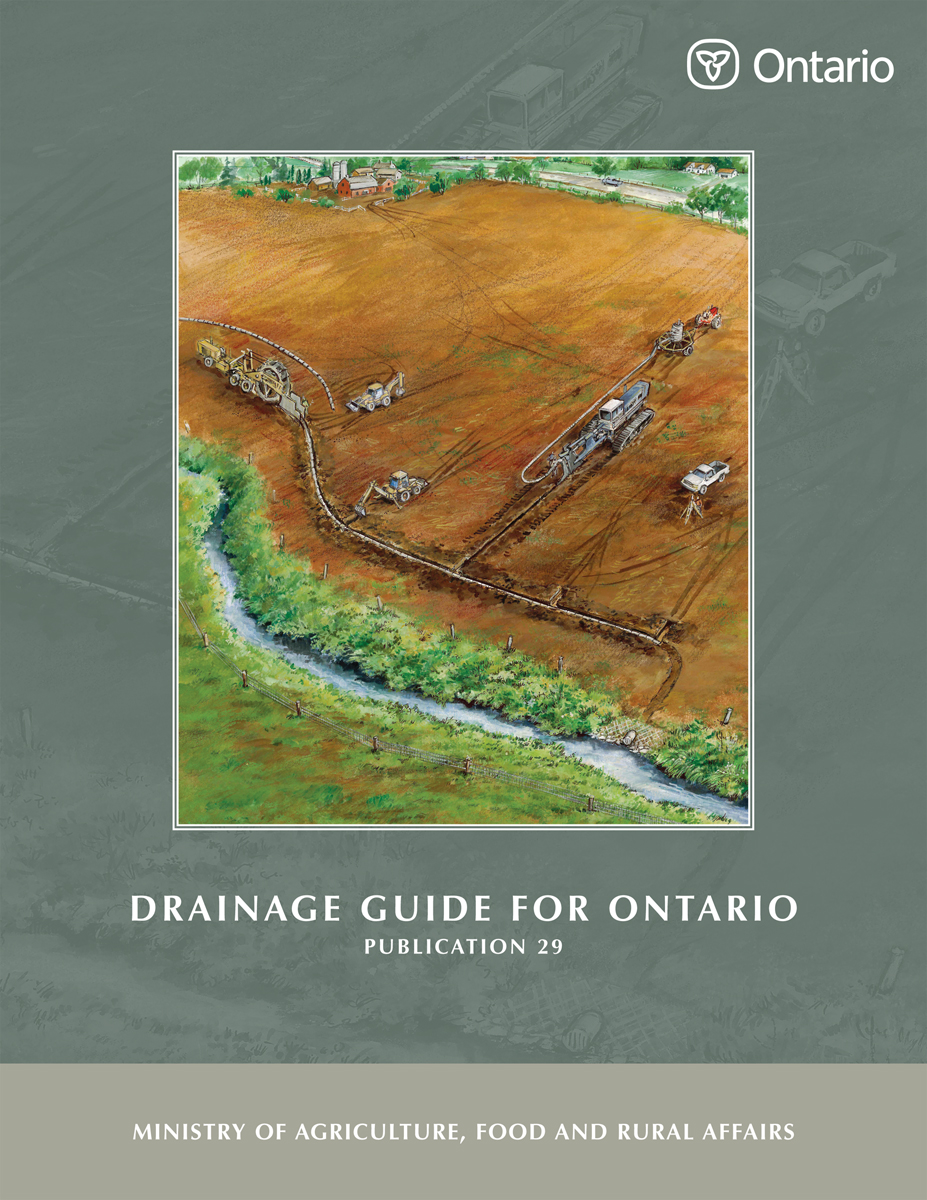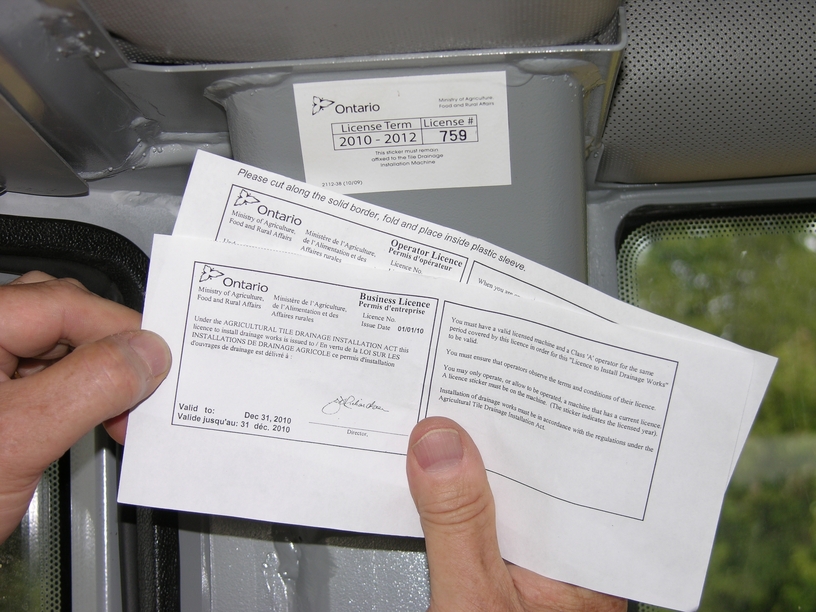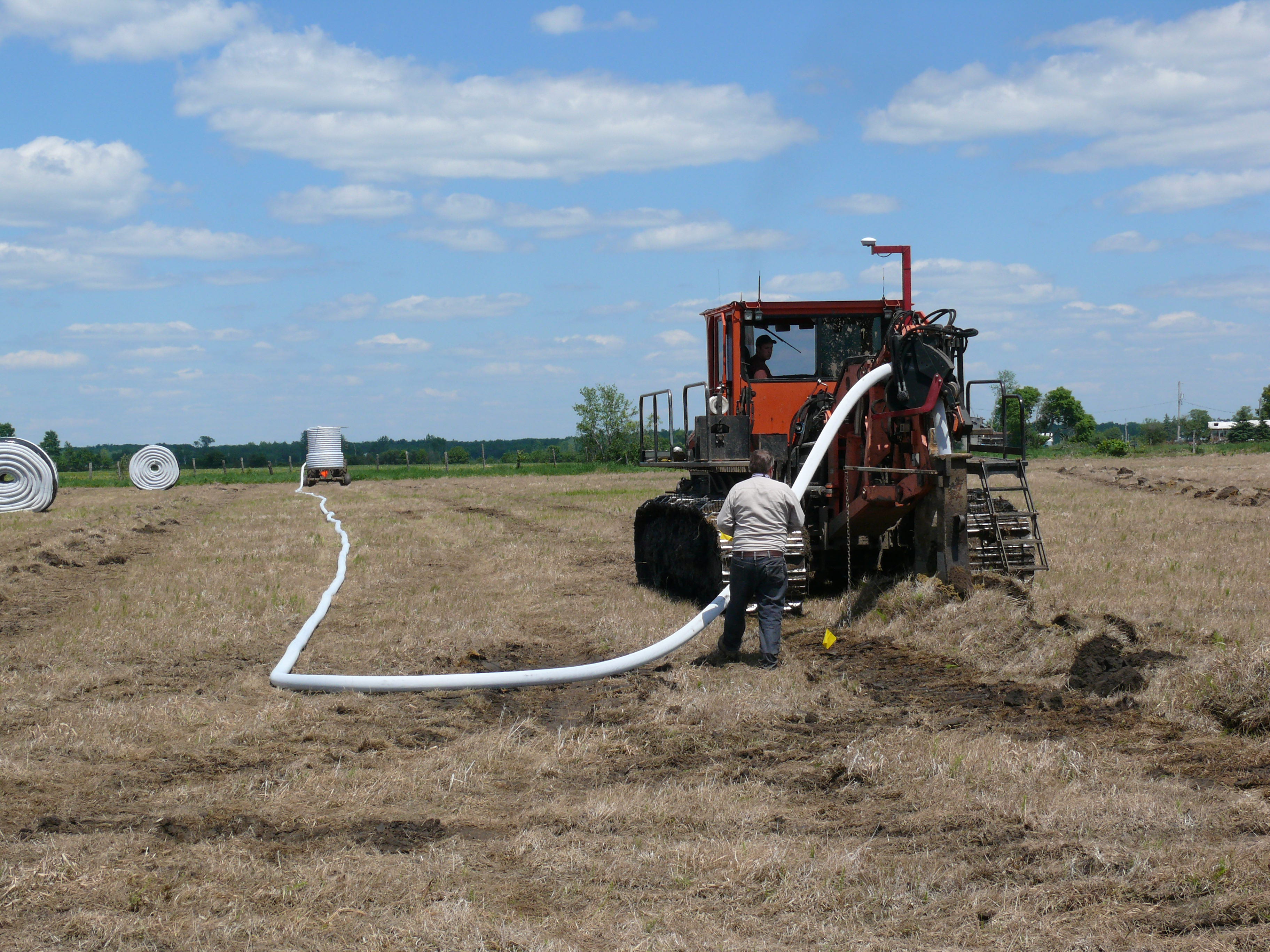Agricultural drainage licensing
Learn about the licensing requirements for tile drainage contractors, including the process to become licensed. This technical information is for tile drainage contractors in Ontario.
ISSN 1198-712X, Published December 2024
Introduction
The installation of tile drainage is a very common land improvement practice among farmers in Ontario. Tile drainage systems usually consist of a series of pipes made of corrugated plastic tubing (called laterals) installed beneath the surface of agricultural land to drain excess water from the crop root zone. These laterals are connected to a main drain that takes the collected water to an outlet such as a drain, under the Drainage Act, 1990, or a natural watercourse. The benefits of tile drainage for crop productivity, farm efficiency and for reducing environmental impacts have been studied and are generally well known to farmers.
This fact sheet provides information on the licensing requirements for tile drainage contractors, including the process to become licensed. It also outlines the Ministry of Agriculture, Food and Agribusiness (OMAFA) role in inspection and enforcement of the Agricultural Tile Drainage Installation Act, 1990.
Overview of the legislation
For a tile drainage system to work effectively, it must be carefully and accurately designed and installed. The Agricultural Tile Drainage Installation Act, 1990 (ATDIA), and the associated O. Reg. 18 was passed to regulate all businesses, machines and machine operators involved in installing a “drainage works” in Ontario. Publication 29: Drainage Guide for Ontario (Figure 1) sets out minimum guidelines on the design and installation of tile drainage systems.

Anyone who installs tile drainage on someone else’s agricultural land using a tile drainage machine, must be licensed under the ATDIA. However, the ATDIA does not apply in the following situations:
- the installation of tile drainage systems on non-agricultural land such as golf courses or sports fields
- the installation of tile drainage systems by an individual on their own property using their own drainage machine
- the installation of municipal drains constructed under the Drainage Act, 1990 if the drainage report does not require a licensed contractor
- tile installed by means of a backhoe or other type of machine not specifically intended to install tile drains
The official definition of a “drainage works” is a drainage system constructed of tile, pipe or tubing of any material beneath the surface of agricultural land, including integral inlets and outlets, for the purpose of improving the productivity of the land drained.
Administration of the legislation
OMAFA is responsible for administering the ATDIA, which includes issuing, suspending or revoking all licenses under the Act and any investigation and inspection of tile drainage activities in Ontario on an as-needed basis.
Drainage courses are offered to teach course participants to survey fields, design and lay out tile drainage systems and understand the principles necessary to successfully install tile.
Licences under the ATDIA
There are 3 types of licences (Figure 2) issued under the Agricultural Tile Drainage Installation Act, 1990:
- machine licence
- operator licence
- business licence

Machine licence
Each machine used to install tile drainage on agricultural land must be licensed. The licence is usually issued to the business that owns the machine. OMAFA tests all drainage machine models built by the different manufactures to ensure they are capable of installing tile to the grades and depths set out in Publication 29: Drainage Guide for Ontario. After a model of machine has been tested and approved, any new machines of the approved model may be licensed without further testing.
When a drainage contractor buys a used machine that is currently licensed in Ontario, the licence can be transferred to the new owner. The transfer may trigger a random inspection of that machine. If a used machine has never before been licensed in Ontario or the machine has been brought back into Ontario, it must be inspected. The machine must pass the inspection before a licence will be issued even if it is an approved model.
Complete and submit an online application for:
Submit forms by mail or e-mail to:
OMAFA — Environmental Management Branch
Becky Curran
3rd Floor, Southeast
1 Stone Road, West
Guelph, Ontario N1G&nbp;4Y2
drainage.implements.nutrients@ontario.ca
Operator licence
Anyone operating a tile drainage machine must have an operator licence. Operators are required to fulfil certain obligations, including supervised experience operating machines installing drainage works and the successful completion of drainage courses, in order to upgrade their licences.
Three classes of operator’s licences are:
- Class “C” operators are apprentice operators. They may only operate a drainage machine under the constant supervision of a Class “A” operator. To obtain this licence, the applicant must have at least 60 days’ experience carrying out other duties (that is not operating the machine) working with a tile drainage business.
- Class “B” operators are mid-level apprentice operators. They may operate drainage machines on their own, provided a Class “A” operator is present and in actual contact at least once every 3-hour period. To upgrade to a Class “B” licence, an individual must have passed the Primary Drainage Course and have at least 250 hours experience operating drainage machines as a Class “C” operator.
- Class “A” operators are experienced operators who can perform all the work necessary to plan and install a tile drainage system. To upgrade a Class “B” licence to a Class “A,”, an individual must have passed the Advanced Drainage Course and have at least 500 hours’ total experience as a Class “B” or “C” operator, operating a tile drainage machine. The applicant must also pass an inspection conducted by the Provincial Drainage Inspector.
Complete and submit an online application:
- Tile Drainage — Machine Operator’s Licence
- Tile Drainage — Upgrade a Machine Operator’s Licence
Submit forms by mail or e-mail to:
OMAFA — Environmental Management Branch
Becky Curran
3rd Floor, Southeast
1 Stone Road, West
Guelph, Ontario N1G 4Y2
drainage.implements.nutrients@ontario.ca
The Primary Drainage Course provides participants with the knowledge and skills necessary to understand common surveying terms, establish drainage slopes, grade changes and depths, and ensure installations comply with Publication 29: Drainage Guide for Ontario.
The Advanced Drainage Course provides participants with the knowledge and skills required to assess, plan and design agricultural sub-surface drainage works. Learners will gain an understanding of tile drainage design, so that design and installation will comply with Publication 29: Drainage Guide for Ontario.
Business licence
Every contractor who installs tile drainage systems on agricultural land must have a business licence. The licence is issued to a business that employs a Class “A” machine operator and has access to (owns or rents) a licensed drainage machine.
The drainage inspector must inspect all applicants applying for a business licence for the first time. This is to ensure that the business has the skills and equipment necessary to install tile drainage systems properly.
Complete and submit an online application:
Submit forms by mail or e-mail to:
OMAFA — Environmental Management Branch
Becky Curran
3rd Floor, Southeast
1 Stone Road, West
Guelph, Ontario N1G 4Y2
drainage.implements.nutrients@ontario.ca
Existing tile drainage businesses in Ontario must renew their business licence annually. However, an inspection is not needed to renew a business licence. To renew, a record (tile drainage record) of each tile drainage project installed in the previous year must be submitted to OMAFA along with the application to renew and the licence fee.
Inspections and enforcement
An OMAFA drainage inspector completes the inspections required for the licensing of drainage machines, operators and businesses (Figure 3).

Inspections are also completed when property owners have a complaint about the quality of the tile drainage system installed by a licensed contractor. Property owners should first discuss their concerns with the contractor who installed the system. Any unresolved workmanship issues can be directed to OMAFA at ag.info.omafa@ontario.ca.
An inspection report is issued by OMAFA to the contractor and the property owner with recommendations for additional work, if any. OMAFA will follow up with the complainant and if the contractor does not address the deficiencies, a hearing may be scheduled before the Director. If it is determined that a licensed business has committed an offence under the Act, licences may be suspended or revoked.
OMAFA also investigates the installation of tile drainage by unlicensed individuals. When individuals install tile without the required licences, they may be prosecuted in the courts for offences under the ATDIA. If found guilty, the fine may be up to $2,000 for a first offence. A fine for a second conviction may be as much as $5,000.
Review a list of licensed tile drainage contractors in Ontario who design and install agricultural tile drainage systems. Landowners should request to see a copy of the operator’s, the business and machine licences prior to the contractor starting any work on their property.
Author credits
This fact sheet was written by Tim Brook, P. Eng., drainage program coordinator, OMAFA. It was reviewed by Andy Kester, drainage analyst/inspector, OMAFA, and Amber Langmuir, P. Eng., water management engineering specialist, OMAFA.